Greetings to all! I hope you'll join us for the next installment of
the Cephalopod Coffeehouse, an online gathering of bloggers who love
books. The next meeting is set for Friday, October 27th. If you're
interested, please sign on to the link list at the end of this post.
The
idea is simple: on the last Friday of each month, post about the best
book you've finished over the past month while visiting other bloggers
doing the same. In this way, we'll all have the opportunity to share
our thoughts with other enthusiastic readers. Please join us:
"If more of us valued food and cheer and song over hoarded gold, it would be a merrier world." - J.R.R. Tolkien
Saturday, September 30, 2017
Friday, September 29, 2017
Cephalopod Coffeehouse: September 2017
Welcome one and all to the Cephalopod Coffeehouse, a cozy gathering of
book lovers, meeting to discuss their thoughts regarding the works they
enjoyed most over the previous month. Pull up a chair, order your
cappuccino and join in the fun. If you wish to add your own review to
the conversation, please sign on to the link list at the end of my post.
Title: March: Book One
Writers: John Lewis and Andrew Aydin
Artist: Nate Powell
Racial tension is nothing new in the United States. In truth, it is the central theme of our history. This land was not "settled" by Europeans. It was stolen. Our economy was dependent on African slave labor for generations. More than once, our government has used an attack by foreign powers as an excuse to betray its own citizens. Obviously, the events in Charlottesville brought the issues into sharper focus than we've seen in a long time. But pretending this is a new or even reawakened problem is ignorant, naive, delusional or worse.
Congressman John Lewis is a genuine American hero, a front line veteran of the Civil Rights Movement. In the three-part graphic novel series March, Lewis tells the story of his life in the struggle. Book One begins in medias res, Lewis joining in the march across the bridge in Selma in 1965, then jumps ahead to the morning of Obama's inauguration in 2009, then back to Lewis's childhood in rural Alabama. This first volume about his early life takes us up to his experience with the lunch counter sit-ins in Nashville in 1960.
Lewis's reflections on discrimination and the fight to end it are deeply personal. He recalls the conversations he had on the bridge in Selma, the pain of realizing what separate but equal meant to his own education and the challenges of training for non-violent resistance. As much as we might pat ourselves on the back for the progress made in the half-century since Selma, the lessons of Lewis's story are just as relevant now. Equality is incrementally closer but still a long way off. It has been heartening, in the weeks since Charlottesville, to see that so many are still willing to take a stand. May Lewis's example serve us all in our always uncertain yet forever hopeful future.
Please join us and share your own review of your best read from the past month. This month's link list is below. I'll keep it open until the end of the day. I'll post October's tomorrow. Meetings are the last Friday of each month. Next gathering is October 27th.
Title: March: Book One
Writers: John Lewis and Andrew Aydin
Artist: Nate Powell
 |
| via Amazon |
Congressman John Lewis is a genuine American hero, a front line veteran of the Civil Rights Movement. In the three-part graphic novel series March, Lewis tells the story of his life in the struggle. Book One begins in medias res, Lewis joining in the march across the bridge in Selma in 1965, then jumps ahead to the morning of Obama's inauguration in 2009, then back to Lewis's childhood in rural Alabama. This first volume about his early life takes us up to his experience with the lunch counter sit-ins in Nashville in 1960.
Lewis's reflections on discrimination and the fight to end it are deeply personal. He recalls the conversations he had on the bridge in Selma, the pain of realizing what separate but equal meant to his own education and the challenges of training for non-violent resistance. As much as we might pat ourselves on the back for the progress made in the half-century since Selma, the lessons of Lewis's story are just as relevant now. Equality is incrementally closer but still a long way off. It has been heartening, in the weeks since Charlottesville, to see that so many are still willing to take a stand. May Lewis's example serve us all in our always uncertain yet forever hopeful future.
Please join us and share your own review of your best read from the past month. This month's link list is below. I'll keep it open until the end of the day. I'll post October's tomorrow. Meetings are the last Friday of each month. Next gathering is October 27th.
Labels:
Book Club,
comics,
good reading,
graphic novels,
non-fiction books
Tuesday, September 26, 2017
What Is The Clone Wars?
 |
| via Wikipedia |
The Clone Wars serves many purposes. Multiply 121 episodes by 22 minutes and you have over 44 hours to flesh out the Star Wars universe. The Mos Eisley cantina clientele implies dozens of worlds to explore and The Clone Wars visits several of them. More interesting to this blogger, the show's best stories explore broader moral questions. In particular, are the Jedi and the Republic truly the unassailable good guys we've always been lead to believe?
The morals at the beginning of each episode imply fables. But whom are these fables for and who is the teller? Are they to be told over a bar table? at a campfire? at a child's bedside? I have a guess about Star Wars's Aesop and I'll get to that as we explore the particulars.
Is the show perfect? Definitely not. Some of the stories are downright groan-inducing. Also, with the various threads and multi-episode arcs, it would be difficult for the casual viewer to tune in any old week and feel drawn in. Of course, that's true of a lot of TV shows these days but I can see how it might have been a drawback for The Clone Wars.
Still, overall I like the show. It makes me curious about Rebels but I'm going to hold off on that one for a while. Let's hand out the hardware...
Favorite Episode: "Rookies"
"Rookies" doesn't even feel like Star Wars most of the time as it's not ultimately about Jedi, Sith, droids or any of the usual trappings. It's a story about grunt clone soldiers assigned to a remote outpost, a brutally tedious life until suddenly it isn't. We hear their guy banter and the songs they listen to on the radio. It feels more like an old war movie from the 1950s than the galaxy far, far away.
When all goes wrong, we find out what these young guns are really made of, how devoted they are to their duty and, ultimately, to one another. This is the moment that pulls the clones away from any concept of mindless conformity. They have minds and hearts. The loss of any one is felt by all. The climactic scene is genuinely heart-wrenching. I teared up. The creators themselves thought enough of the story that they produced both a prequel ("Clone Cadets") and a sequel ("ARC Troopers") for Season Three.
The episode also introduces Fives. More on him in a bit.
Least Favorite Episode: "A Sunny Day in the Void"
The droid stories are tiresome at best. It's a challenge to pick just one to highlight (lowlight?). "A Sunny Day in the Void" is the second of a four-part droid arc (good lord!). The setting is a desert planet, and not one with the elegant Tunisian dunes of Tatooine. This one is simply flat and empty with dentist office lighting. It's as if some creative genius thought to combine the tedium of a rudderless narrative with the thrill of sensory deprivation. Torturous.
Favorite Arc: Mortis
If some trusting friend had time for only one story arc, I would pick Mortis. Anakin, Obi-Wan and Ahsoka stumble upon a planet pulled out of time. The three residents are a father, his daughter and his son. The three are acting out an ongoing morality play with the daughter representing the light side of the Force, the son the dark and Dad the arbiter between. The outcome of the struggle is said to have fateful bearing on the galaxy as a whole. The father is fading and wants Anakin to take his place. He is essentially offering the power of a god.
I don't know if Mortis is truly the best story of the series but it was certainly the one that left me with the most to write about. For the devoted, it provides ample material for discussing the basic moral landscape of the Star Wars franchise.
Favorite Principal Character: Ahsoka Tano
 |
| via Wikipedia |
At first, Ahsoka's main narrative purpose along with the others was to reflect her master: Anakin as a teacher, Anakin as a bad influence, Anakin as a whiny child with attachment issues, etc. But by the fifth season, Ahsoka's experiences pull her further and further away from Anakin and, ultimately, the Jedi Order. Her departure from the narrative is the single most shocking and revealing moment of the entire series.
In light of this path, I came to see Ahsoka as The Clone Wars storyteller. Perhaps Anakin's role is still the focus but these fables are Ahsoka's cautionary tales to... someone. I get the much touted idea of the droids as the Star Wars chroniclers but, again, those morals imply a lesson to be learned. Who better than a fallen Jedi to teach them?
And why write Ahsoka out of the story? Was it part of a broader narrative plan, cut short by the series's abrupt cancellation? Or, was it a more deliberate choice to get her out of the way so the show's creators could get back to the Anakin-centered show they really wanted?
Favorite Recurring Character, Previously Established: Asajj Ventress
 |
| via Darthpedia |
Ventress is also an important link to Star Wars's Kurosawa legacy. Her name is drawn from Asaji, the Lady Macbeth equivalent in Throne of Blood.
Favorite Recurring Character, New: Fives
 |
| via Wookieepedia |
As noted previously, Fives is introduced in "Rookies" as one of the five clone troopers in Domino Squad. He also appears in Season Three's Citadel arc and Season Four's Umbara arc. In the Inhibitor Chip arc, he and his droid pal AZI-3 get awfully close to uncovering the terrible secret of Order 66, the Sith's plan to destroy the Jedi by manipulating the clones. Through Fives, we get our most intimate view of the complicated relationship between the clones, the Jedi and the Republic, the best thread going in The Clone Wars series.
Best Threads
The Clone Wars is not one story but several threads interwoven. As might be expected, some paths proved rich in narrative possibilities while others were mostly annoying. The threads listed below were by no means the only good ones, though they were the most satisfying to me. Nor are they mutually exclusive. The episodes where they intersect are some of the best of the entire run. In approximate order of preference:
Clones - The very existence of the clones presents a moral dilemma. The folks we have been led to see as the good guys in this struggle wage war with a genetically-engineered slave army. The clones themselves are almost invariably loyal, dependable and respectable but to say their relationship with the Jedi who lead them is complicated is putting it mildly. All of the stories in this thread are strong, including several of the series's best single-episode tales.
Ahsoka - The Ahsoka thread takes a while to get going, or at least for the viewer (and the writers?) to recognize that her story is developing apart from Anakin's. Eventually, she, and we, are led to see the struggle between Republic and Separatists in a different light. From there, her transformation happens incrementally. By the end, she's questioning everything about the cause and, more to the point, her place in it. Unfortunately for all of us, this story ends just at the moment when it starts to get really good.
Ghosts - This thread is only two arcs long but it packs a lot of punch. It begins with the Mortis arc described above and wraps up with the final arc of the series, The Clone Wars's most substantial Yoda story. These tales focus on the more mystical aspects of the Force, allowing us to explore the moral landscape of the Star Wars universe with minimal narrative clutter. If one were to design a college course or discussion group around the philosophy of Star Wars, this thread would be required viewing.
Ventress - After her fall out with Count Dooku, Assaj Ventress's thread takes us to Dathomir, easily my favorite of the worlds introduced in The Clone Wars. There, we meet her family, the Nightsisters, well-worthy of a spinoff series or standalone film of their own. On Dathomir, she also encounters Savage Opress, one of the best new characters in his own right. The Ventress thread leads to the unfortunate resurrection of Darth Maul but even that branch thread has its moments. Eventually, Assaj's path bends back around to intersect with Ahsoka's for a meaningful Season Five encounter.
 |
| Duchess Satine via Wookieepedia |
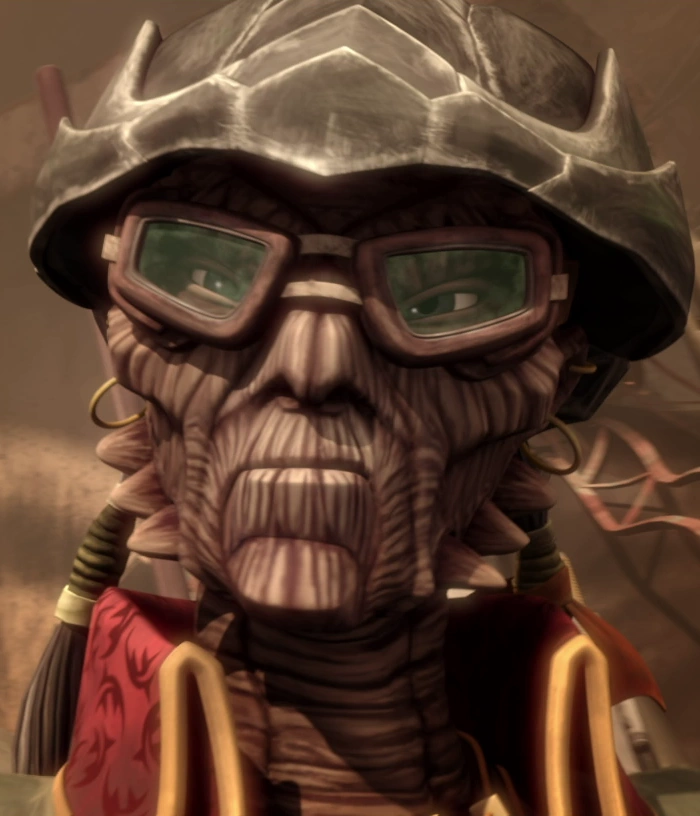 |
| Hondo via Wookieepedia |
Clone Wars 101: A Ten-Episode Introduction:
The following is not a top ten list. While several would certainly qualify for that too, a number of my favorites are not included here. Instead, I have imagined a scenario in which I introduce the series to a curious friend (or more likely, my daughter) to what I see as the strongest aspects of The Clone Wars series. Each is an early story in one of the threads listed above so if it sparks interest, there is an obvious path for further exploration. Listed in order of original air date:
"Ambush" (Season 1, Episode 1) - The series begins and ends with Yoda stories, interesting as they're really the only Clone Wars stories with the little green Jedi as the protagonist. In addition to showing off his badass fighting skills, Yoda clearly indicates to the clones that he values them as individuals. It would be nice to say that attitude sets the tone for the rest of the series but, in fact, we learn over time that not all Jedi feel the same way - for some, quite the contrary. Asajj Ventress also puts in an appearance.
"Rookies" (1.5) - Simply the best. See above.
"Hidden Enemy" (1.16) - This is another important clones story, and a more troubling one. There's a traitor in the ranks and Cody and Rex are out to find him. The episode is intended as a prequel to the Clone Wars movie. Ventress appears again.
"Storm Over Ryloth" (1.19) - In trying to run a blockade, Ahsoka ignores orders and gets most of her squadron killed as a result. While certainly an important development story for Ahsoka, it also paints a clear picture of the relative status between the Jedi and the clones
"The Deserter" (2.10) - While hunting down General Grievous on the planet Saleucami, Rex meets Cut, a clone deserter, and his family. Over the rest of the story, Rex and Cut debate duty vs. personal choice.
"Mandalore Plot" (2.12) - Our first visit to Mandalore, where we meet Duchess Satine on one side of a civil war and Death Watch on the other.
"Bounty Hunters" (2.17) - Dedicated to the legendary Akira Kurosawa, "Bounty Hunters" is a Clone Wars send up of the Japanese filmmaker's masterpiece: The Seven Samurai. The episode title is misleading. While there are bounty hunter characters in the story, they are hardly the focus. Hondo is the villain, though this is not his first appearance. If I were to extend my orientation tour to eleven episodes, the addition would be "Dooku Captured," Hondo's introduction.
"Heroes on Both Sides" (3.10) - This episode represents a big moment for Ahsoka, especially in hindsight. While accompanying Padmé on a trip to Raxus, the Separatist capital, she meets Lux Bonteri, son of a Separatist senator. For Ahsoka and for us, Lux offers a perspective on the struggle she's never seen before. Not only are some of the Separatists nice people, some of them actually have legitimate gripes against the Republic and even the Jedi. Lux comes back for a vital arc in Season Five, one in which Ahsoka takes yet another small but crucial step in her personal journey.
"Nightsisters" (3.12) - The first step of Ventress's personal journey. As noted above, Dathomir is one world where I would happily spend more time.
"Overlords" (3.15) - The beginning of the Mortis arc. There is some good Ahsoka material here, too, but it's mostly an Anakin story, and probably the best one.
*****
This is a long post. Congratulations and thank you if you made it all the way through. I thought about splitting the material into multiple posts but I found with Star Trek that I refer back to these wrap-ups and it's useful having everything in one place.
Also, a big thank you and congratulations to Andrew Leon, my partner in crime for this journey and the man who suggested it in the first place. I probably would have gotten to the series on my own eventually but exploring it with another Star Wars devotee was more meaningful. Andrew is continuing on with the unfinished Legacy episodes so be sure to check out his posts for those.
Labels:
Clone Wars project,
comics,
good reading,
sources,
Star Wars,
TV
Friday, September 22, 2017
Squid Mixes: Havana Club
We are planning to spend Thanksgiving with the English Prof and the Playwright. A nautical theme is in the works so I have been experimenting with rum-based cocktails in anticipation. I got this recipe from The New York Bartender's Guide: light rum and dry vermouth in 6:1 proportion. It is essentially a martini with rum instead of gin, skip the olive. I'm assuming it was named for Havana Club rum, a Cuban brand and one of the best selling rums in the world, though not in the United States. Because of the trade embargo, Havana Club has been banned in the States since 1960. Rest easy. I used Bacardi.
I thought it was alright but my wife didn't care for it. "Too rummy," she said, "and a bit oily." I guess that tells me plenty, really. I was hoping for a drink that would showcase the rum itself but obviously that's not going to suit her. Fortunately, we have another idea to try soon that I expect will be more in line with her tastes.
I forgot to take a picture before drinking mine. So, here is a photo of a red-spotted newt instead:
I thought it was alright but my wife didn't care for it. "Too rummy," she said, "and a bit oily." I guess that tells me plenty, really. I was hoping for a drink that would showcase the rum itself but obviously that's not going to suit her. Fortunately, we have another idea to try soon that I expect will be more in line with her tastes.
I forgot to take a picture before drinking mine. So, here is a photo of a red-spotted newt instead:
Labels:
cocktails,
family adventures,
food,
food books,
good reading,
non-fiction books
Thursday, September 21, 2017
The Clone Wars: Season Six
We have reached the end of Season Six, The Lost Missions, in our exploration of The Clone Wars. I will post a reflection on the entire series next Tuesday. But first, a quick look at this most recent stretch.
General Impressions
Anyone who has watched as much television as I have catches on to the basic pattern quickly: most shows end poorly. The creative well runs dry after a while. The lack of fresh ideas leaves the writers relying too heavily on the audience's investment in characters and on predictable narrative patterns.
Not so for The Clone Wars. All due credit to George Lucas, the Star Wars well never seems to run dry. Whatever criticism one might throw at him, you can say this much for his galaxy far, far away: there is always more to explore. While the episodes produced for The Clone Wars were, to the end, decidedly uneven, the overall quality was awfully high in the last two seasons. Season Six includes only four arcs. The first is outstanding. The last is strong. The second has its moments. Even the one clunker would be okay minus Jar Jar. Best of all for me, no droid episodes.
Favorite Episode: "Conspiracy"
The opening Inhibitor Chip arc is the gem of Season Six. Following right on the heels of Season Five's excellent finale, the story comes darn close to exposing the secret of Order 66, the plan executed in Revenge of the Sith for the clone troopers to slaughter nearly all of the Jedi simultaneously. More importantly to me, it explores the basic dilemma of the existence of the Clone Army more deeply than any other story in the series. The star of the tale is Fives, a clone trooper we first met in Season One's "Rookies." "Conspiracy" is the second episode in the four-parter and the one in which Fives's role kicks into gear.
Least Favorite Episode: "The Disappeared, Part I"
The Disappeared arc is a Jar Jar story: 'nuff said, really. It's a Jar Jar love story, even. His wing man for the episode is Mace Windu: also odd. This story might have been more interesting without Jar Jar but we'll never know. "Part II" is rescued by a surprise cameo so "Part I" gets the nod.
Favorite New Character: AZI-345211896246498721347
AZI-3 is a medical droid and Fives's sidekick in the Inhibitor Chip arc. His voice grates on me a little (sorry, Ben Diskin) and I find the comic relief he offers off-putting at times but he's still an essential part of one of the best stories in the entire series. Plus, he doubles as a jet ski!
Onward?
No, this is it for me. For anyone who's eager for more, there are unfinished episodes to watch at StarWars.com and also comic books of other unused stories. But there are no more on Netflix. I have one more post next week to wrap up this 2-year+ project but then it's time to move on to other things.
Please visit my friend Andrew Leon today for his Season Six recap. Next Tuesday: "What Is The Clone Wars?," my full series review.
General Impressions
Anyone who has watched as much television as I have catches on to the basic pattern quickly: most shows end poorly. The creative well runs dry after a while. The lack of fresh ideas leaves the writers relying too heavily on the audience's investment in characters and on predictable narrative patterns.
Not so for The Clone Wars. All due credit to George Lucas, the Star Wars well never seems to run dry. Whatever criticism one might throw at him, you can say this much for his galaxy far, far away: there is always more to explore. While the episodes produced for The Clone Wars were, to the end, decidedly uneven, the overall quality was awfully high in the last two seasons. Season Six includes only four arcs. The first is outstanding. The last is strong. The second has its moments. Even the one clunker would be okay minus Jar Jar. Best of all for me, no droid episodes.
Favorite Episode: "Conspiracy"
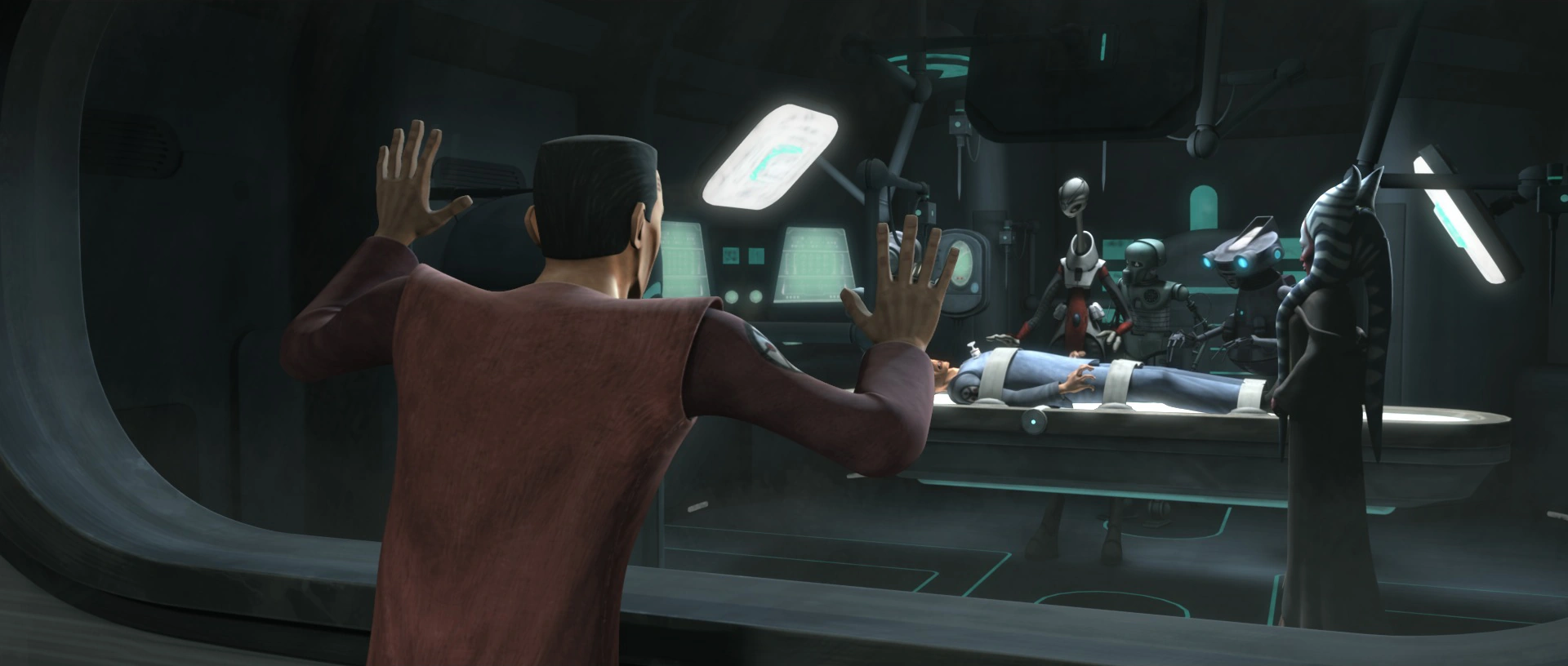 |
| via Wookieepedia |
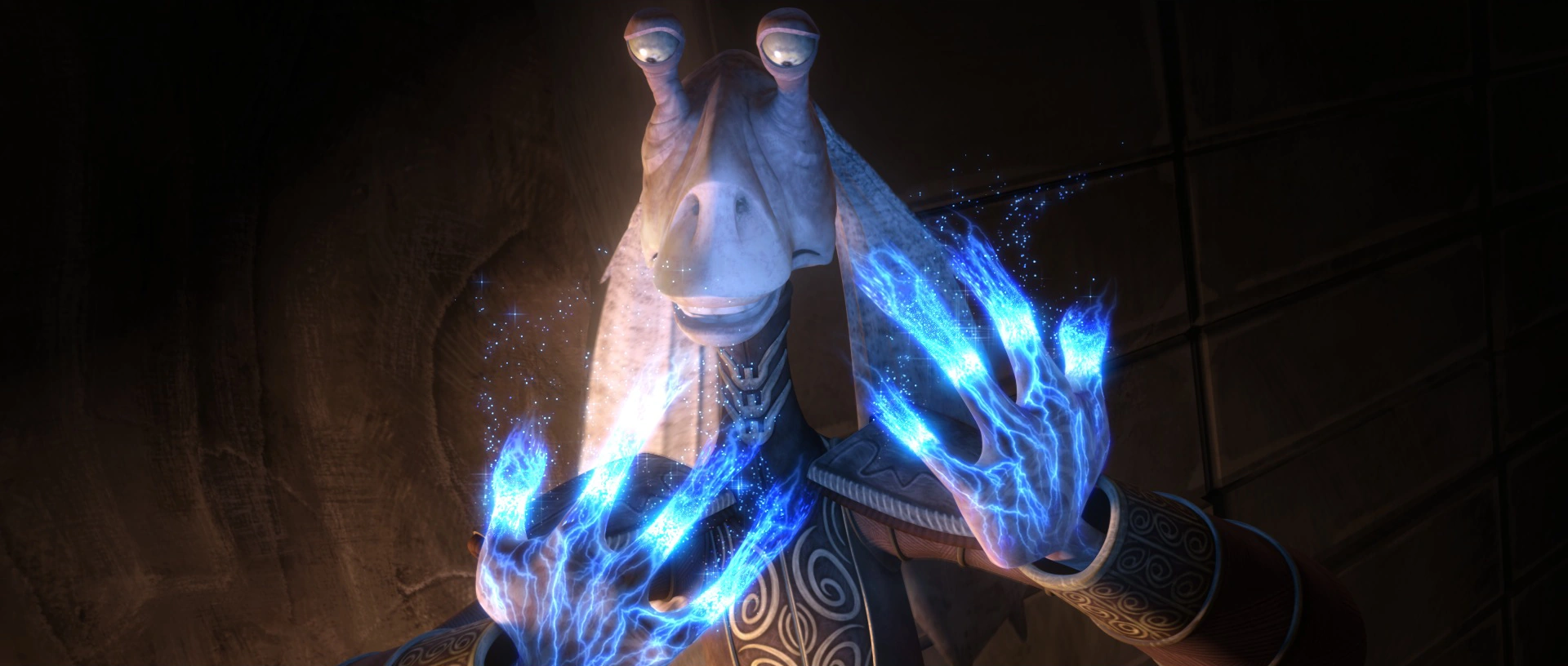 |
| via Wookieepedia |
Favorite New Character: AZI-345211896246498721347
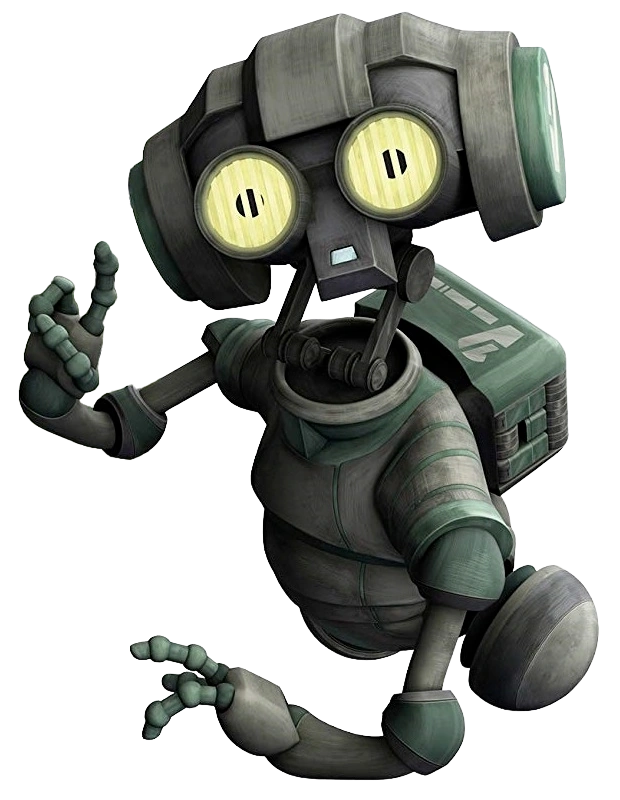 |
| via Wookieepedia |
Onward?
No, this is it for me. For anyone who's eager for more, there are unfinished episodes to watch at StarWars.com and also comic books of other unused stories. But there are no more on Netflix. I have one more post next week to wrap up this 2-year+ project but then it's time to move on to other things.
Please visit my friend Andrew Leon today for his Season Six recap. Next Tuesday: "What Is The Clone Wars?," my full series review.
Labels:
Clone Wars project,
comics,
good reading,
sources,
Star Wars,
TV
Tuesday, September 19, 2017
The Clone Wars: Sacrifice
Andrew Leon and I are watching Star Wars: The Clone Wars.
Every Tuesday, we will be featuring an episode from the series which
began in 2008.
Episode: "Sacrifice"
Series: Star Wars: The Clone Wars
The Lost Missions (Season Six), Episode 13
Original Air Date: March 7, 2014
"Sacrifice" concludes a four-part arc and with it, the entire Clone Wars series. The Force Priestesses from last week have sent Yoda on his final trial to the Sith homeworld of Moraband where he must confront evil at its source. As a final treat for the devoted, Mark Hamill voices Darth Bane, one of the spirits Yoda encounters there.
This arc was written by Christian Taylor, the same screenwriter who wrote the outstanding Mortis arc in Season Three. In many ways, this Yoda arc is a continuation of the same story, a similar exploration of the mystical side of the Star Wars universe. While it is stronger than most of the arcs in the series, it doesn't quite live up to Mortis. Part of it is our faith in Yoda. Apart from the fact that we know he survives, one never even truly doubts that Yoda will succumb to temptation whereas that's always a worry with Anakin. I enjoyed the worlds explored, particularly the visit to Dagobah, and this is the most development we get for Yoda in the series. But the basic story didn't pull me in the way Mortis did.
On Moraband, Yoda finally encounters Sifo-Dyas (or at least an image thereof), the long lost Jedi who pulled him into this adventure in the first place. I think another source of my disappointment here is that while the Sifo-Dyas story was merely a device, it is worthy of exploration on its own merits and it wasn't much. Sifo-Dyas is the one who authorized the creation of the Clone Army, against the Jedi Council's wishes at the time. The series leaves us with dangling threads - not entirely surprising in light of the abrupt cancellation but disappointing nonetheless.
Sifo-Dyas first appeared in The Eyes of Revolution, a comic written and drawn by Warren Fu, published in the collection Star Wars: Visionaries in 2005. Ze fodias is a naughty expression in Portuguese so the character's name was changed to Zaifo-Vias for the Brazillian audience. Apparently Portuguese is fraught with peril for Star Wars characters. Count Dooku was changed to Count Dokan for similar reasons though I can't find the exact translation for that. Sifo-Dyas was voiced by Paul Nakauchi.
Paul Nakauchi is an American actor with extensive stage, film, television and video game credentials. He has performed in several different productions of the musical The King and I, including as King Phra Meha Mongkut for Broadway Asia. On film, he has worked on The Great Raid, Alpha and Omega and the upcoming Death Note. Television credits include Knots Landing, Star Trek: Deep Space Nine and ER. Voice work on video games includes Call of Duty: World at War, Tomb Raider: Legend and World of Warcraft.
And just like that, it's over...
This Thursday, we'll be recapping Season Six. Next Tuesday, I'll offer my summation of the entire series. Then, it's on to other things.
Episode: "Sacrifice"
Series: Star Wars: The Clone Wars
The Lost Missions (Season Six), Episode 13
Original Air Date: March 7, 2014
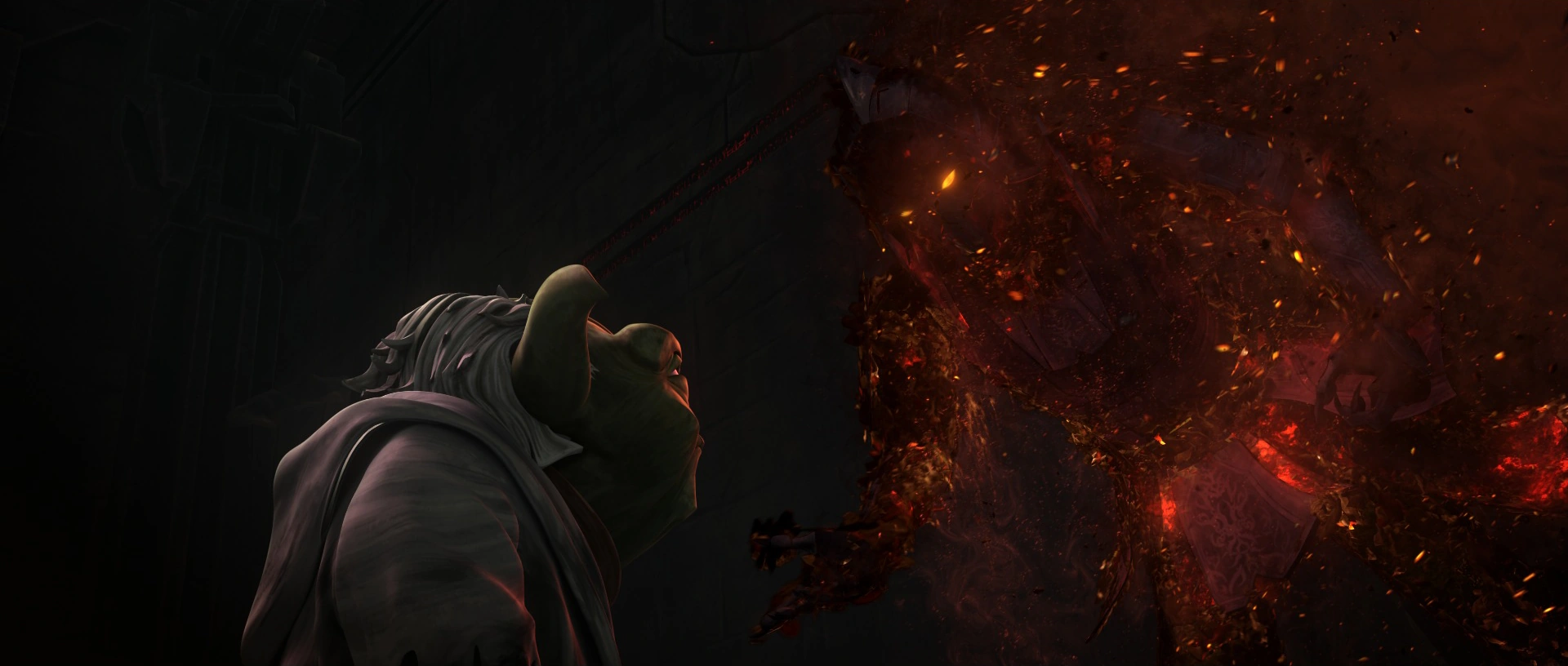 |
| via Wookieepedia |
This arc was written by Christian Taylor, the same screenwriter who wrote the outstanding Mortis arc in Season Three. In many ways, this Yoda arc is a continuation of the same story, a similar exploration of the mystical side of the Star Wars universe. While it is stronger than most of the arcs in the series, it doesn't quite live up to Mortis. Part of it is our faith in Yoda. Apart from the fact that we know he survives, one never even truly doubts that Yoda will succumb to temptation whereas that's always a worry with Anakin. I enjoyed the worlds explored, particularly the visit to Dagobah, and this is the most development we get for Yoda in the series. But the basic story didn't pull me in the way Mortis did.
On Moraband, Yoda finally encounters Sifo-Dyas (or at least an image thereof), the long lost Jedi who pulled him into this adventure in the first place. I think another source of my disappointment here is that while the Sifo-Dyas story was merely a device, it is worthy of exploration on its own merits and it wasn't much. Sifo-Dyas is the one who authorized the creation of the Clone Army, against the Jedi Council's wishes at the time. The series leaves us with dangling threads - not entirely surprising in light of the abrupt cancellation but disappointing nonetheless.
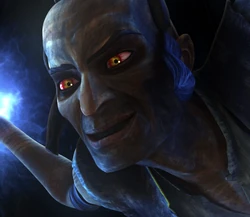 |
| via Wookieepedia |
 |
| via Game of Thrones Wiki |
And just like that, it's over...
This Thursday, we'll be recapping Season Six. Next Tuesday, I'll offer my summation of the entire series. Then, it's on to other things.
Labels:
Clone Wars project,
comics,
good reading,
music,
sources,
Star Wars,
TV
Monday, September 18, 2017
On the Coffee Table: Showa 1953-1989
Title: Showa 1953-1989: A History of Japan
Writer and Artist: Shigeru Mizuki
This is the fourth and final volume of Mizuki's outstanding Showa comic book series. My reflections on the first three books can be found here, here and here.
Japan's Showa era was defined by the reign of Emperor Hirohito:
1926-1989, a period of extraordinary national transformation. Mizuki
lived through it all and his books weave historical events with his own
personal experiences.
This installment covers by far the longest time span of the four volumes, well over half of the Showa period. It's a particularly important era for me personally because it includes the time when Japan became a vital part of my family's life. My parents first moved to Japan in 1969 and stayed for seven years (Showa 44-51). Both learned far more Japanese than I ever did. My older sister and I were both born in Tokyo. The book even includes an event with which my father was directly involved: Emperor Hirohito's visit to the United States in 1975. My parents have never talked much about the student protests and political corruption that were going on during their time in Japan. Maybe with the relative isolation of diplomatic life, it didn't affect them too much. Maybe after two years in Laos, Japan was relatively stable. Maybe it's just not the sort of stuff you talk about with young children.
As the book and the Showa era close, my own time in Japan is nearing. I went back to teach for two years, 1996-98 (Heisei 8-10). As such, the Japan in the book comes to look a lot more like the Japan I knew. Japanese cities aren't exactly beautiful but familiar sights tug at the heartstrings nonetheless.
What I appreciate most about the Showa series is Mizuki's attention to cultural history in addition to all of the military, political and economic details. He shares the TV shows, movies, fashion magazines and songs that were popular. He seems especially interested in crime tales, going into too vivid detail with several headline grabbing stories. In fact, if I have one criticism, it's that sometimes, the book's a little gross. Mizuki loooooooves potty humor.
That said, I am now half-tempted to go back and re-read Mizuki's other work, especially GeGeGe no Kitaro, his most famous comic. I probably won't but I would have a greater appreciation now that I know more about the author's life. I am also grateful for the history lesson about a country that has been so important to me.
Writer and Artist: Shigeru Mizuki
 |
| via Amazon |
This installment covers by far the longest time span of the four volumes, well over half of the Showa period. It's a particularly important era for me personally because it includes the time when Japan became a vital part of my family's life. My parents first moved to Japan in 1969 and stayed for seven years (Showa 44-51). Both learned far more Japanese than I ever did. My older sister and I were both born in Tokyo. The book even includes an event with which my father was directly involved: Emperor Hirohito's visit to the United States in 1975. My parents have never talked much about the student protests and political corruption that were going on during their time in Japan. Maybe with the relative isolation of diplomatic life, it didn't affect them too much. Maybe after two years in Laos, Japan was relatively stable. Maybe it's just not the sort of stuff you talk about with young children.
As the book and the Showa era close, my own time in Japan is nearing. I went back to teach for two years, 1996-98 (Heisei 8-10). As such, the Japan in the book comes to look a lot more like the Japan I knew. Japanese cities aren't exactly beautiful but familiar sights tug at the heartstrings nonetheless.
What I appreciate most about the Showa series is Mizuki's attention to cultural history in addition to all of the military, political and economic details. He shares the TV shows, movies, fashion magazines and songs that were popular. He seems especially interested in crime tales, going into too vivid detail with several headline grabbing stories. In fact, if I have one criticism, it's that sometimes, the book's a little gross. Mizuki loooooooves potty humor.
That said, I am now half-tempted to go back and re-read Mizuki's other work, especially GeGeGe no Kitaro, his most famous comic. I probably won't but I would have a greater appreciation now that I know more about the author's life. I am also grateful for the history lesson about a country that has been so important to me.
Labels:
Asian Lit,
children's literature,
comics,
good reading,
non-fiction books,
Showa,
trades
Friday, September 15, 2017
Squid Mixes: Negroni
The Negroni is one of my wife's favorite cocktails. My recipe is from The New York Bartender's Guide: gin, Campari and sweet vermouth in 4:2:1 proportion. The garnish is an orange twist - tough to see in the photo but it's in there. The main difference between this and the old pal cocktail I made earlier this summer (see here) is the use of gin rather than rye. The flavor is quite similar.
The drink's origins are unclear but probably Florence in around 1919. The origin of the name, however, is well-documented. The Negroni family produced a ready-made version of the drink. So Negroni, like Campari itself, is a brand name and thus generally capitalized.
Labels:
cocktails,
family adventures,
food,
food books,
good reading,
non-fiction books
Wednesday, September 13, 2017
On the Coffee Table: Daniel Goleman
Title: Emotional Intelligence: Why It Can Matter More Than IQ
Author: Daniel Goleman
I am currently in a master's program - about 13 credits in, I think. Last summer's class was on leadership and this book - or parts of it - was one of the assigned texts. I finally got around to reading the whole thing.
The idea of emotional intelligence (EI, measured by EQ) comes from the theory of multiple intelligences set forth by Dr. Howard Gardner in 1983. Wikipedia defines EI as "the capability of individuals to recognize their own and other people's emotions, discern between different feelings and label them appropriately, use emotional information to guide thinking and behavior, and manage and/or adjust emotions to adapt to environments or achieve one's goal(s)." Goleman asserts that EI is a far greater indicator of success in life than the more traditional measures: grades, SATs, IQ tests.
The book explores the role of EI in numerous contexts: work, school, family life, violent crime, etc. Goleman's argument is thorough and convincing. The material on brain function is less interesting to me personally, though admittedly essential to overall understanding. Some of his real-life anecdotes are fairly intense, enough that it's difficult to concentrate on the text that follows - interesting as Goleman explains how such stories have been used in clinical studies. It's not an easy book to digest in one sitting, at least not for me - lots of starting and stopping with time to ponder in between.
It's certainly a book that leaves me wanting to post-game various stages of my own life - childhood certainly. Thinking back, I can remember several friends who were popular for all of the right reasons - i.e., people simply enjoyed being around them. Emotional intelligence certainly played a role there. The text shed new light on a lot of my own relationships, too: familial, romantic, collegial, what have you. While it's not a book I'll instantly start recommending it to everyone I know, I am grateful for the insights and will suggest it to some.
 |
| via Amazon |
The idea of emotional intelligence (EI, measured by EQ) comes from the theory of multiple intelligences set forth by Dr. Howard Gardner in 1983. Wikipedia defines EI as "the capability of individuals to recognize their own and other people's emotions, discern between different feelings and label them appropriately, use emotional information to guide thinking and behavior, and manage and/or adjust emotions to adapt to environments or achieve one's goal(s)." Goleman asserts that EI is a far greater indicator of success in life than the more traditional measures: grades, SATs, IQ tests.
The book explores the role of EI in numerous contexts: work, school, family life, violent crime, etc. Goleman's argument is thorough and convincing. The material on brain function is less interesting to me personally, though admittedly essential to overall understanding. Some of his real-life anecdotes are fairly intense, enough that it's difficult to concentrate on the text that follows - interesting as Goleman explains how such stories have been used in clinical studies. It's not an easy book to digest in one sitting, at least not for me - lots of starting and stopping with time to ponder in between.
It's certainly a book that leaves me wanting to post-game various stages of my own life - childhood certainly. Thinking back, I can remember several friends who were popular for all of the right reasons - i.e., people simply enjoyed being around them. Emotional intelligence certainly played a role there. The text shed new light on a lot of my own relationships, too: familial, romantic, collegial, what have you. While it's not a book I'll instantly start recommending it to everyone I know, I am grateful for the insights and will suggest it to some.
Labels:
business books,
good reading,
non-fiction books,
science books
Tuesday, September 12, 2017
The Clone Wars: Destiny
Andrew Leon and I are watching Star Wars: The Clone Wars.
Every Tuesday, we will be featuring an episode from the series which
began in 2008.
Episode: "Destiny"
Series: Star Wars: The Clone Wars
The Lost Missions (Season Six), Episode 12
Original Air Date: March 7, 2014
In this, the third episode of a four-part arc, Yoda travels to a mysterious world that is the source of midi-chlorians, the microscopic life form through which the Force speaks in the Star Wars galaxy. Once there, he is set upon several trials by the Five Priestesses, trials not dissimilar to the ones he will eventually set for Luke on Dagobah. I sense many homages in this episode. The Priestesses look a lot like No-Face in Miyazki's Spirited Away. Much of the world's aesthetic seems awfully Tim Burtonesque. In one trial, Yoda confronts his own dark side shadow, reminiscent of Tolkien's Gollum.
There is much discussion among the writers themselves as to whether or not the Priestesses are five beings or five aspects of one being. In the story, they represent five emotions: Serenity, Anger, Confusion, Joy and Sadness. This episode and the next mark their only appearances. All are voiced by Jaime King.
Next week: "Sacrifice."
Episode: "Destiny"
Series: Star Wars: The Clone Wars
The Lost Missions (Season Six), Episode 12
Original Air Date: March 7, 2014
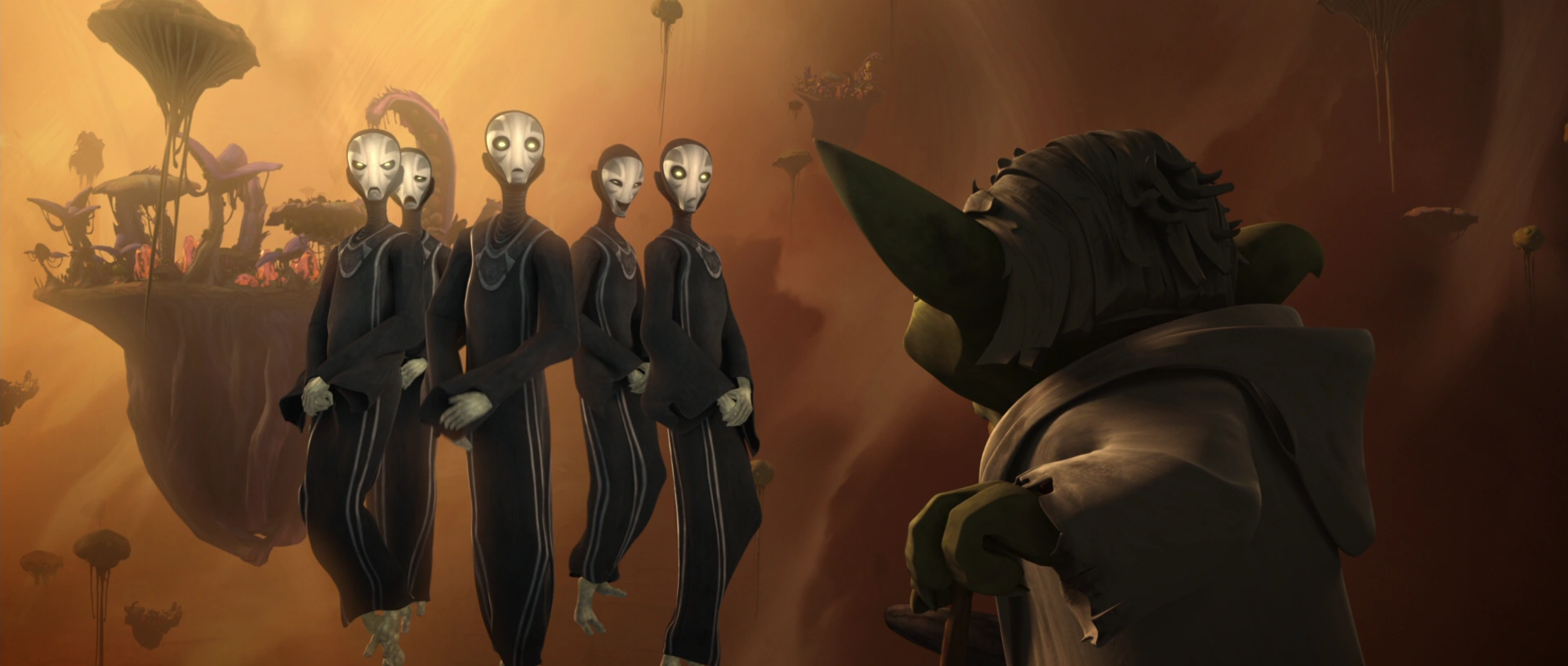 |
| via Wookieepedia |
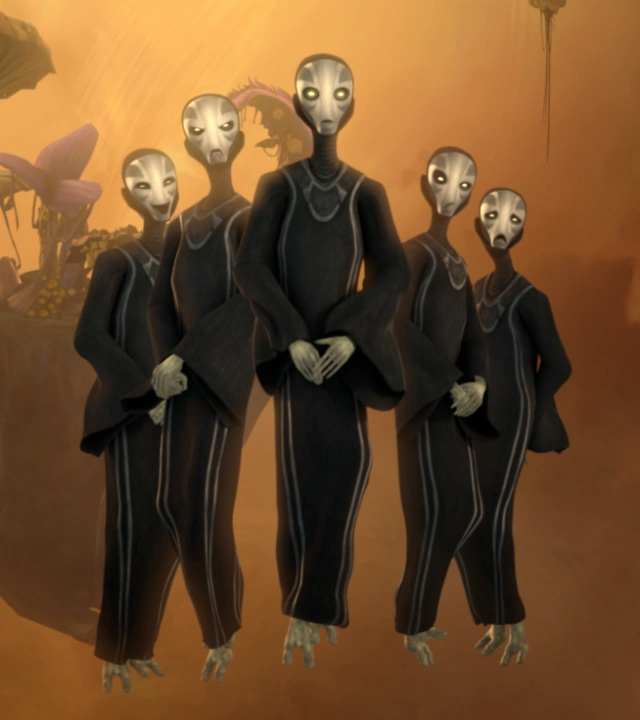 |
| via Wookieepedia |
Next week: "Sacrifice."
Labels:
Clone Wars project,
comics,
good reading,
sources,
Star Wars,
TV
Friday, September 8, 2017
Squid Mixes: Manhattan
 |
| via my wife |
The Manhattan was most certainly invented in New York, one of numerous cocktails named for the city's five boroughs. Accounts date its creation as far back as the 1860s. Several variations exist, some varying the base liquor, others switching to dry vermouth, still more toying around with different bitters. The most intriguing to me is the Fourth Regiment which includes dashes of orange, celery and Peychaud's bitters.
Labels:
cocktails,
family adventures,
food,
food books,
good reading,
non-fiction books
Tuesday, September 5, 2017
The Clone Wars: Voices
Andrew Leon and I are watching Star Wars: The Clone Wars.
Every Tuesday, we will be featuring an episode from the series which
began in 2008.
Episode: "Voices"
Series: Star Wars: The Clone Wars
The Lost Missions (Season Six), Episode 11
Original Air Date: March 1, 2014
This week's episode is the second in a four-part arc. Yoda is hearing voices, specifically that of Qui-Gon Jinn. Worried that he may have come under the influence of the dark side, the Jedi Council advises medical observation. With Anakin's help, Yoda escapes the Jedi Temple in order to pursue this voice on his own terms. This story is interesting for a lot of reasons, not least for the fact that the idea of a Force Spirit is previously unknown in the timeline, apart from the experience on Mortis which was deemed an hallucination.
If I am honest with myself, my adoration for the Star Wars franchise mostly revolves around a single movie: The Empire Strikes Back. I am thoroughly prepared to argue for Empire as greatest film ever made. Wagner would have loved Empire: an extraordinary display of synthesis between all great art forms. Most importantly to our current discussion, it is the heart of the Star Wars story and it introduces my own favorite character: Yoda, an adorable spiritual guru Muppet voiced by Frank Oz. He was tailor-made for me.
In "Voices," Yoda's path leads him to Dagobah, apparently for the first time. Of course, we all know the swamp planet as Yoda's future home, a world with deep connections to The Force. With the familiar sights and sounds and the musical strains of Yoda's Theme, this episode tugged at my heart strings as no other has. This is the Star Wars I love, the one that always leaves me wanting more.
Rig Nema is the Jedi doctor who attends to Yoda at the Temple. Her appearance is based on an early design for Mace Windu, drawn by Ian McCaig, before Samuel L. Jackson was cast.
"Voices" is Nema's only Clone Wars appearance. She is voiced by Catherine Taber.
Next week: "Destiny."
Episode: "Voices"
Series: Star Wars: The Clone Wars
The Lost Missions (Season Six), Episode 11
Original Air Date: March 1, 2014
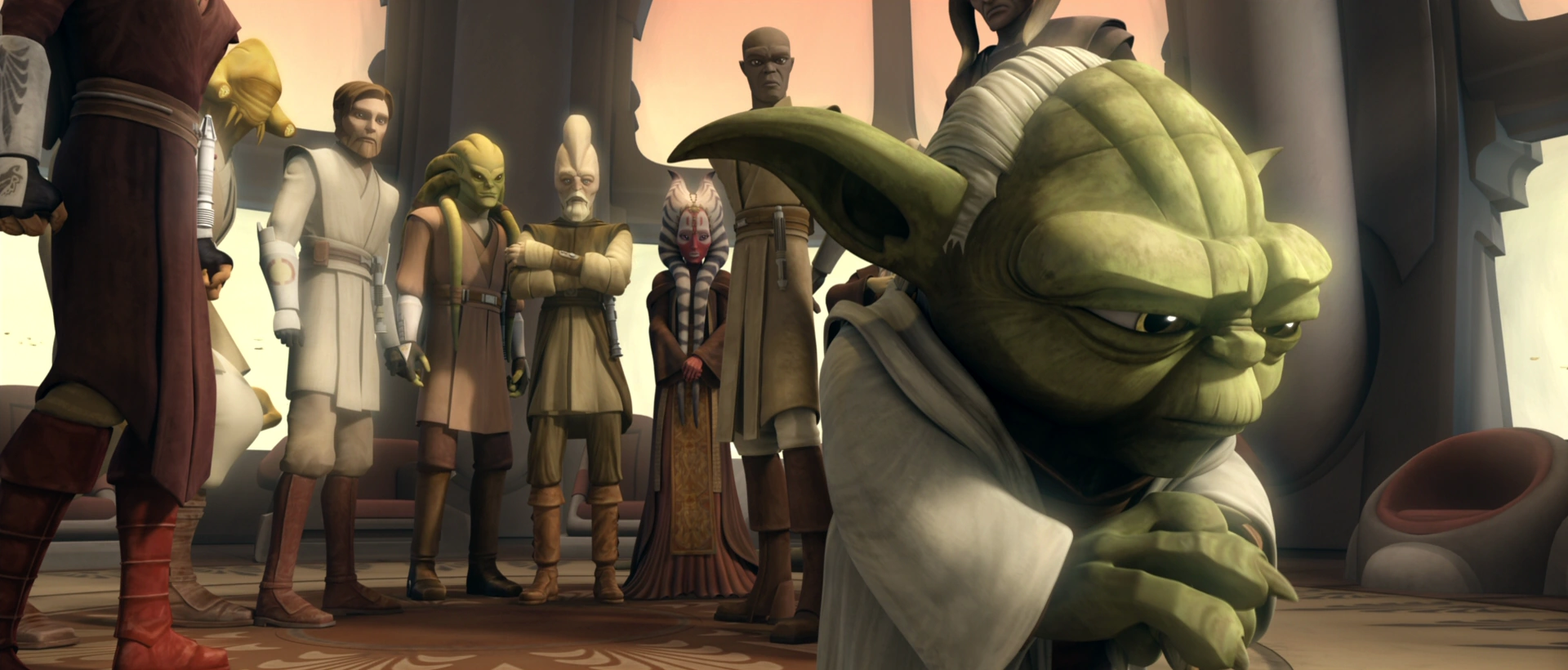 |
| via Wookieepedia |
If I am honest with myself, my adoration for the Star Wars franchise mostly revolves around a single movie: The Empire Strikes Back. I am thoroughly prepared to argue for Empire as greatest film ever made. Wagner would have loved Empire: an extraordinary display of synthesis between all great art forms. Most importantly to our current discussion, it is the heart of the Star Wars story and it introduces my own favorite character: Yoda, an adorable spiritual guru Muppet voiced by Frank Oz. He was tailor-made for me.
In "Voices," Yoda's path leads him to Dagobah, apparently for the first time. Of course, we all know the swamp planet as Yoda's future home, a world with deep connections to The Force. With the familiar sights and sounds and the musical strains of Yoda's Theme, this episode tugged at my heart strings as no other has. This is the Star Wars I love, the one that always leaves me wanting more.
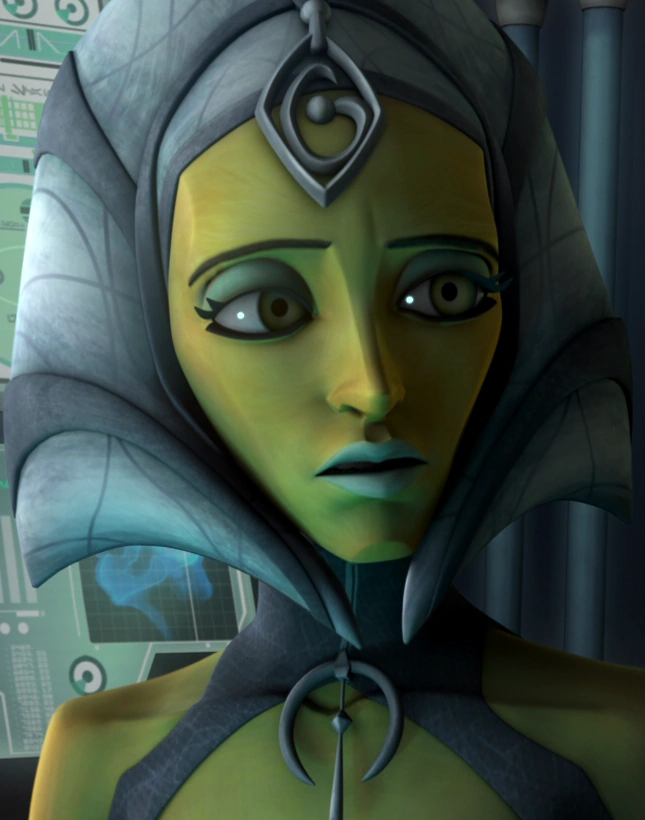 |
| via Wookieepedia |
 |
| via Wookieepedia |
Next week: "Destiny."
Labels:
Clone Wars project,
comics,
good reading,
music,
sources,
Star Wars,
TV
Friday, September 1, 2017
Squid Mixes: Gin Fizz
The gin fizz is the most popular of the broader category of fizz drinks which combine an alcoholic base with an acidic fruit juice and carbonated water. Recipes first appeared in print in 1887. Historically, they were particularly popular in New Orleans. My gin fizz, from The New York Bartender's Guide, involves gin, lemon juice and seltzer. Very refreshing.
Labels:
cocktails,
family adventures,
food,
food books,
good reading,
non-fiction books
Subscribe to:
Posts (Atom)



